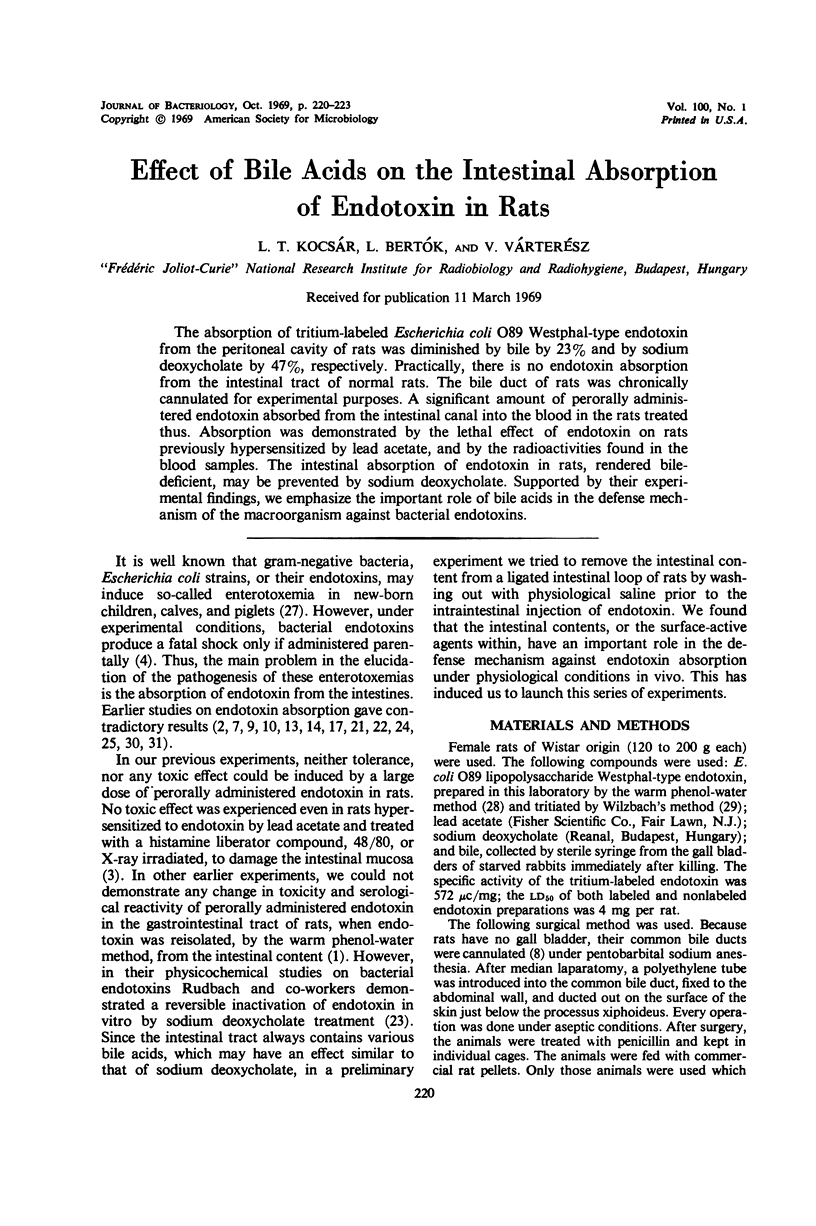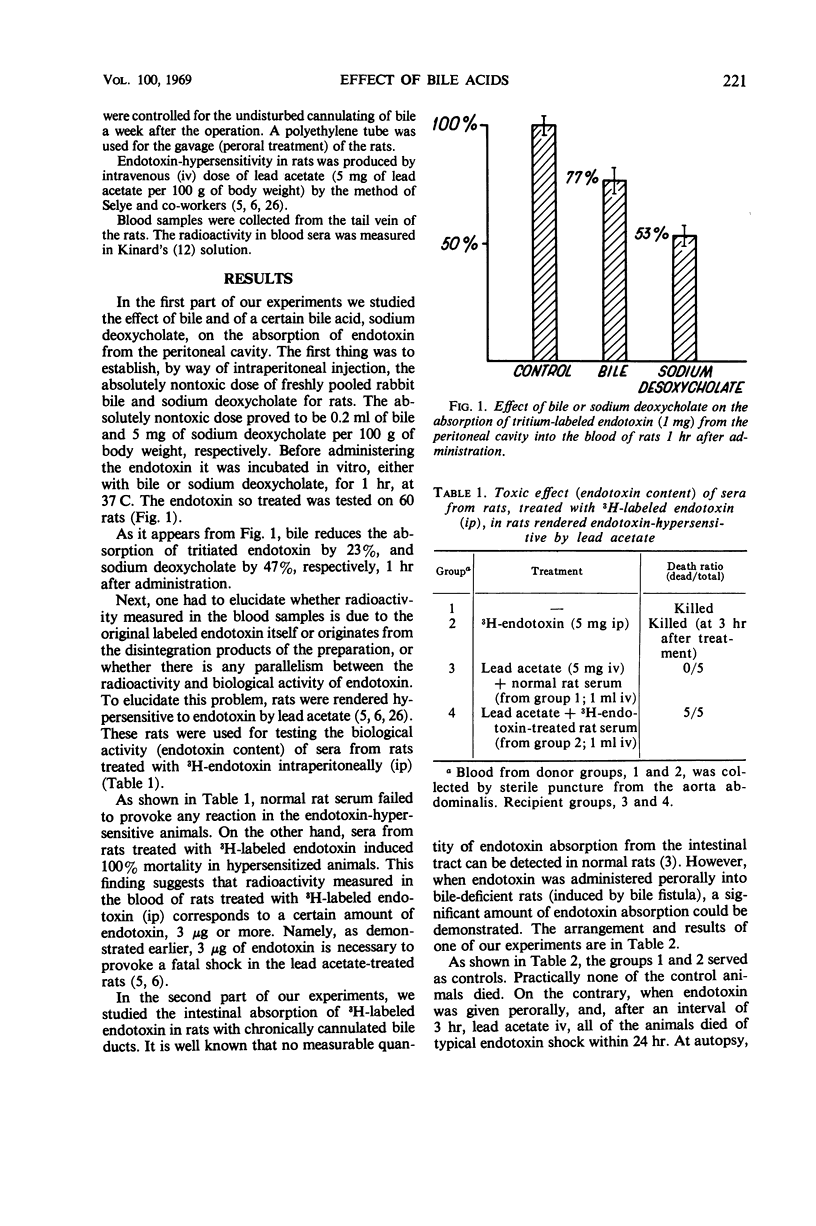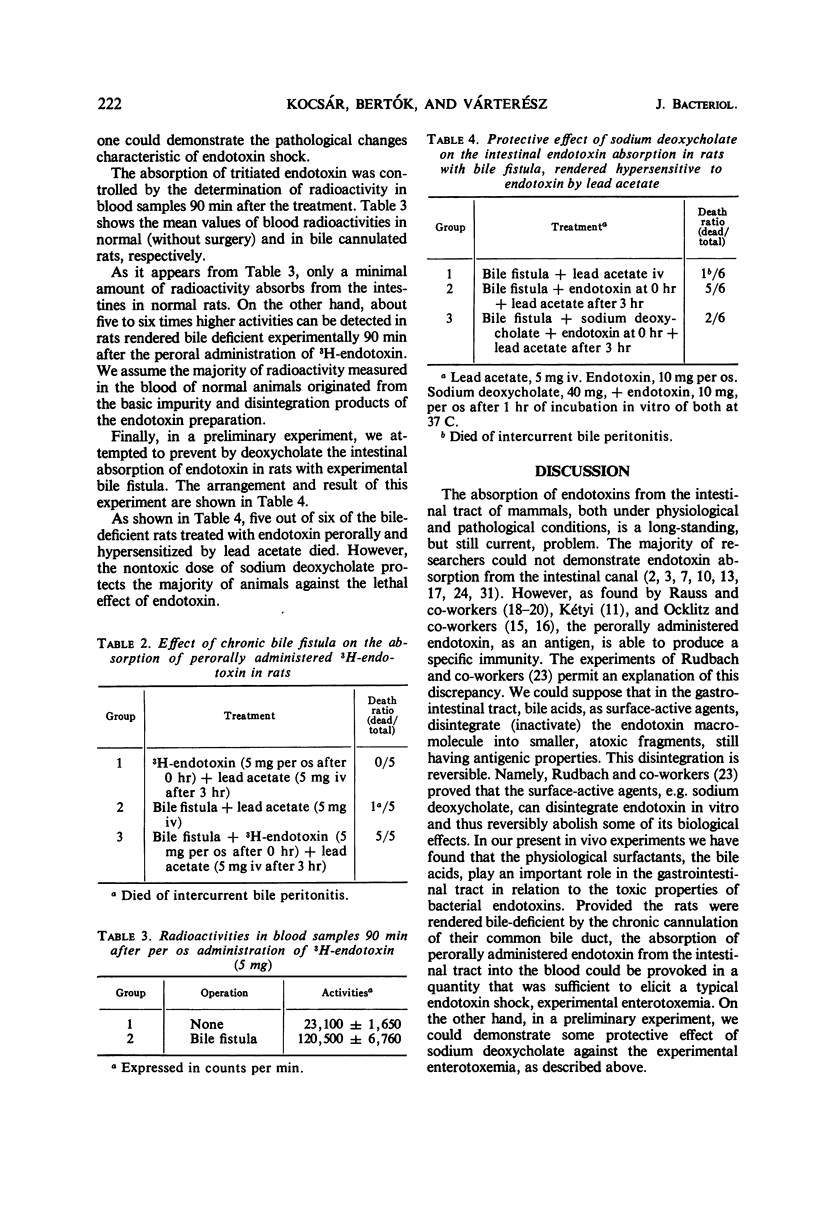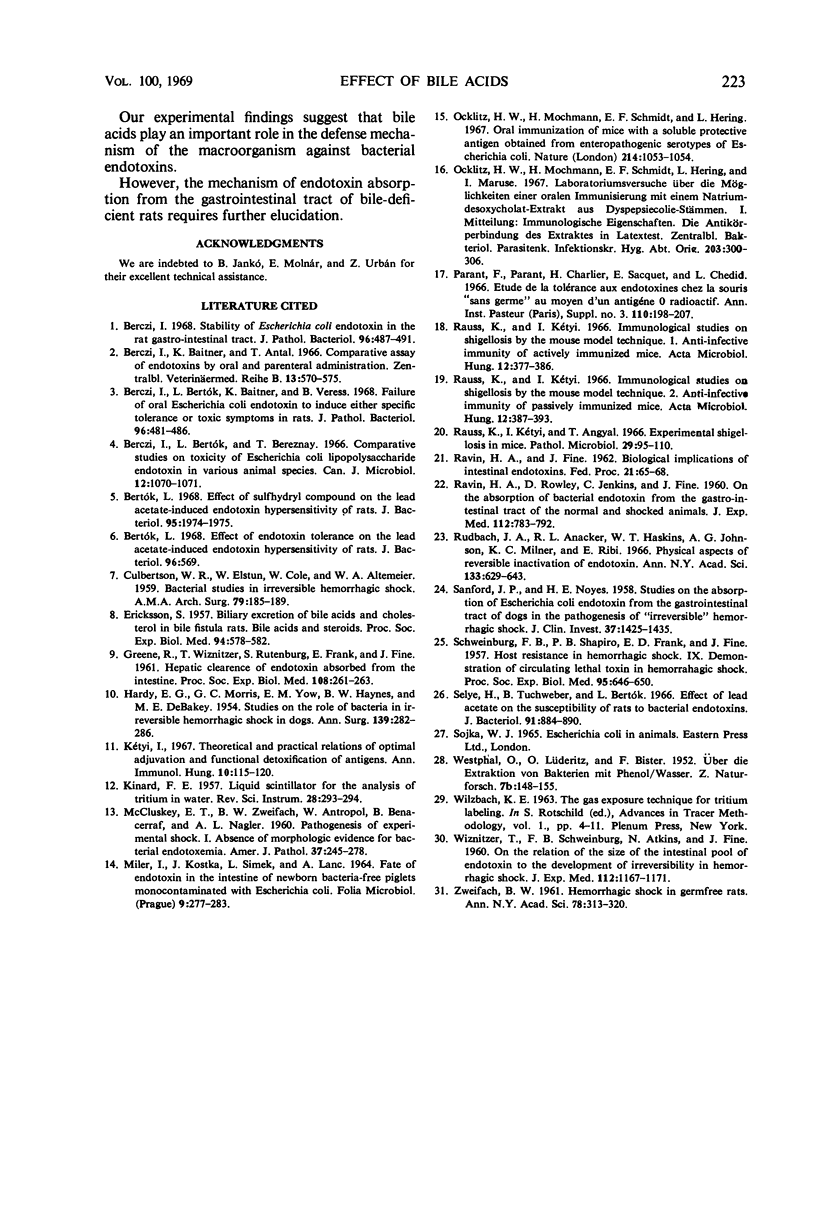Abstract
The absorption of tritium-labeled Escherichia coli O89 Westphal-type endotoxin from the peritoneal cavity of rats was diminished by bile by 23% and by sodium deoxycholate by 47%, respectively. Practically, there is no endotoxin absorption from the intestinal tract of normal rats. The bile duct of rats was chronically cannulated for experimental purposes. A significant amount of perorally administered endotoxin absorbed from the intestinal canal into the blood in the rats treated thus. Absorption was demonstrated by the lethal effect of endotoxin on rats previously hypersensitized by lead acetate, and by the radioactivities found in the blood samples. The intestinal absorption of endotoxin in rats, rendered bile-deficient, may be prevented by sodium deoxycholate. Supported by their experimental findings, we emphasize the important role of bile acids in the defense mechanism of the macroorganism against bacterial endotoxins.
Full text
PDF



Selected References
These references are in PubMed. This may not be the complete list of references from this article.
- Berczi I., Baintner K., Jr, Antal T. Comparative assay of endotoxins by oral and parenteral administration. Zentralbl Veterinarmed B. 1966 Oct;13(6):570–575. doi: 10.1111/j.1439-0450.1966.tb00932.x. [DOI] [PubMed] [Google Scholar]
- Berczi I., Bertók L., Baintner K., Jr, Veress B. Failure of oral Escherichia coli endotoxin to induce either specific tolerance or toxic symptoms in rats. J Pathol Bacteriol. 1968 Oct;96(2):481–486. doi: 10.1002/path.1700960227. [DOI] [PubMed] [Google Scholar]
- Berczi I., Bertók L., Bereznai T. Comparative studies on the toxicity of Escherichia coli lipopolysaccharide endotoxin in various animal species. Can J Microbiol. 1966 Oct;12(5):1070–1071. doi: 10.1139/m66-143. [DOI] [PubMed] [Google Scholar]
- Berczi I. Stability of Escherichia coli endotoxin in the rat gastro-intestinal tract. J Pathol Bacteriol. 1968 Oct;96(2):487–491. doi: 10.1002/path.1700960228. [DOI] [PubMed] [Google Scholar]
- CULBERTSON W. R., ELSTUN W., COLE W., ALTEMEIER W. A. Bacterial studies in irreversible hemorrhagic shock. AMA Arch Surg. 1959 Aug;79(2):185–189. doi: 10.1001/archsurg.1959.04320080021003. [DOI] [PubMed] [Google Scholar]
- ERIKSSON S. Biliary excretion of bile acids and cholesterol in bile fistula rats; bile acids and steroids. Proc Soc Exp Biol Med. 1957 Mar;94(3):578–582. doi: 10.3181/00379727-94-23018. [DOI] [PubMed] [Google Scholar]
- HARDY E. G., MORRIS G. C., Jr, YOW E. M., HAYNES B. W., Jr, DEBAKEY M. E. Studies on the role of bacteria in irreversible hemorrhagic shock in dogs. Ann Surg. 1954 Mar;139(3):282–286. doi: 10.1097/00000658-195403000-00004. [DOI] [PMC free article] [PubMed] [Google Scholar]
- MILER I., KOSTKA J., SIMEK L., LANC A. FATE OF ENDOTOXIN IN THE INTESTINE OF NEWBORN BACTERIA-FREE PIGLETS MONOCONTAMINATED WITH ESCHERICHIA COLI. Folia Microbiol (Praha) 1964 Sep;89:277–283. doi: 10.1007/BF02873306. [DOI] [PubMed] [Google Scholar]
- McCluskey R. T., Zweifach B. W., Antopol W., Benacerraf B., Nagler A. L. Pathogenesis of Experimental Shock: I. Absence of Morphologic Evidence for Bacterial Endotoxemia. Am J Pathol. 1960 Sep;37(3):245–277. [PMC free article] [PubMed] [Google Scholar]
- Ocklitz H. W., Mochmann H., Schmidt E. F., Hering L., Markuse I. Laboratoriumsversuche überdie Möglichkeiten einer oralen Immunisierung mit einem Natriumdeoxycholat-Extrakt aus Dyspepsiecoli-Stämmen. I. Immunbiologische Eigenschaften. Die Antikörperbindung des Extraktes im Latextest. Zentralbl Bakteriol Orig. 1967;203(3):300–306. [PubMed] [Google Scholar]
- Ocklitz H. W., Mochmann H., Schmidt E. F., Hering L. Oral immunization of mice with a soluble protective antigen obtained from enteropathogenic serotypes of Escherichia coli. Nature. 1967 Jun 3;214(5092):1053–1054. doi: 10.1038/2141053a0. [DOI] [PubMed] [Google Scholar]
- Parant F., Parant M., Charlier H., Sacquet E., Chedid L. Etude de la tolérance aux endotoxines chez la souris "sans germes" au moyen d'un antigène O radioactif. Ann Inst Pasteur (Paris) 1966 Mar;110(3 Suppl):198–207. [PubMed] [Google Scholar]
- RAVIN H. A., FINE J. Biological implications of intestinal endotoxins. Fed Proc. 1962 Jan-Feb;21:65–68. [PubMed] [Google Scholar]
- RAVIN H. A., ROWLEY D., JENKINS C., FINE J. On the absorption of bacterial endotoxin from the gastro-intestinal tract of the normal and shocked animal. J Exp Med. 1960 Nov 1;112:783–792. doi: 10.1084/jem.112.5.783. [DOI] [PMC free article] [PubMed] [Google Scholar]
- Rauss K., Kétyi I., Angyal T. Experimental shigellosis in mice. Pathol Microbiol (Basel) 1966;29(1):95–110. doi: 10.1159/000161890. [DOI] [PubMed] [Google Scholar]
- Rauss K., Kétyi I. Immunological studies on shigellosis by the mouse model technique. I. Antiinfective immunity of actively immunized mice. Acta Microbiol Acad Sci Hung. 1965;12(4):377–386. [PubMed] [Google Scholar]
- Rauss K., Kétyi I. Immunological studies on shigellosis by the mouse model technique. II. Antiinfective immunity of passively immunized mice. Acta Microbiol Acad Sci Hung. 1965;12(4):387–393. [PubMed] [Google Scholar]
- Rudbach J. A., Anacker R. L., Haskins W. T., Johnson A. G., Milner K. C., Ribi E. Physical aspects of reversible inactivation of endotoxin. Ann N Y Acad Sci. 1966 Jun 30;133(2):629–643. doi: 10.1111/j.1749-6632.1966.tb52394.x. [DOI] [PubMed] [Google Scholar]
- SANFORD J. P., NOYES H. E. Studies on the absorption of Escherichia coli endotoxin from the gastrointestinal tract of dogs in the pathogenesis of irreversible hemorrhagic shock. J Clin Invest. 1958 Oct;37(10):1425–1435. doi: 10.1172/JCI103733. [DOI] [PMC free article] [PubMed] [Google Scholar]
- SCHWEINBURG F. B., SHAPIRO P. B., FRANK E. D., FINE J. Host resistance in hemorrhagic shock. IX. Demonstration of circulating lethal toxin in hemorrhagic shock. Proc Soc Exp Biol Med. 1957 Aug-Sep;95(4):646–650. doi: 10.3181/00379727-95-23316. [DOI] [PubMed] [Google Scholar]
- Selye H., Tuchweber B., Bertók L. Effect of lead acetate on the susceptibility of rats to bacterial endotoxins. J Bacteriol. 1966 Feb;91(2):884–890. doi: 10.1128/jb.91.2.884-890.1966. [DOI] [PMC free article] [PubMed] [Google Scholar]
- WILZBACH K. E. The gas exposure technique for tritium labeling. Adv Tracer Methodol. 1963;1:4–11. doi: 10.1007/978-1-4684-8619-3_2. [DOI] [PubMed] [Google Scholar]
- WIZNITZER T., SCHWEINBURG F. B., ATKINS N., FINE J. On the relation of the size of the intraintestinal pool of endotoxin to the development of irreversibility in hemorrhagic shock. J Exp Med. 1960 Dec 1;112:1167–1171. doi: 10.1084/jem.112.6.1167. [DOI] [PMC free article] [PubMed] [Google Scholar]
- ZWEIFACH B. W. Hemorrhagic shock in germfree rats. Ann N Y Acad Sci. 1959 May 8;78:315–320. doi: 10.1111/j.1749-6632.1959.tb53116.x. [DOI] [PubMed] [Google Scholar]


